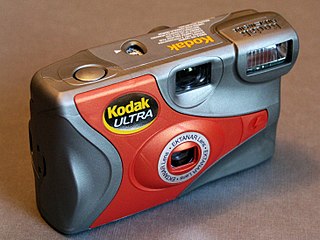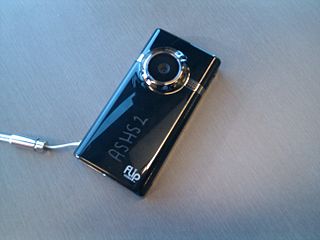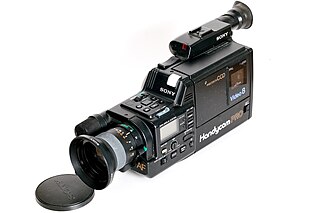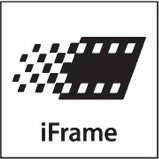
DV is a family of codecs and tape formats used for storing digital video, launched in 1995 by a consortium of video camera manufacturers led by Sony and Panasonic. It includes the recording or cassette formats DV, MiniDV, DVCAM, Digital8, HDV, DVCPro, DVCPro50 and DVCProHD. DV has been used primarily for video recording with camcorders in the amateur and professional sectors.

Panasonic Holdings Corporation is a Japanese multinational electronics company, headquartered in Kadoma, Osaka, Japan. It was founded in 1918 as Matsushita Electric Housewares Manufacturing Works in Fukushima, Osaka by Kōnosuke Matsushita. In 1935, it was incorporated and renamed Matsushita Electric Industrial Co., Ltd. In 2008, it changed its name to Panasonic Corporation. In 2022, it became a holding company and was renamed.

Videotape is magnetic tape used for storing video and usually sound in addition. Information stored can be in the form of either an analog or digital signal. Videotape is used in both video tape recorders (VTRs) and, more commonly, videocassette recorders (VCRs) and camcorders. Videotapes have also been used for storing scientific or medical data, such as the data produced by an electrocardiogram.

Betamax is a consumer-level analog recording and cassette format of magnetic tape for video, commonly known as a video cassette recorder. It was developed by Sony and was released in Japan on May 10, 1975, followed by the US in November of the same year.

Canon Inc. is a Japanese multinational corporation headquartered in Ōta, Tokyo, specializing in optical, imaging, and industrial products, such as lenses, cameras, medical equipment, scanners, printers, and semiconductor manufacturing equipment.

A disposable or single-use camera is a simple box camera meant to be used once. Most use fixed-focus lenses. Some are equipped with an integrated flash unit, and there are even waterproof versions for underwater photography. Internally, the cameras use a 135 film or an APS cartridge.

A camcorder is a self-contained portable electronic device with video and recording as its primary function. It is typically equipped with an articulating screen mounted on the left side, a belt to facilitate holding on the right side, hot-swappable battery facing towards the user, hot-swappable recording media, and an internally contained quiet optical zoom lens.
Betacam is a family of half-inch professional videocassette products developed by Sony in 1982. In colloquial use, Betacam singly is often used to refer to a Betacam camcorder, a Betacam tape, a Betacam video recorder or the format itself.

A video camera is an optical instrument that captures videos, as opposed to a movie camera, which records images on film. Video cameras were initially developed for the television industry but have since become widely used for a variety of other purposes.

Sanyo Electric Co., Ltd. is a Japanese electronics manufacturer founded in 1947 by Toshio Iue, the brother-in-law of Kōnosuke Matsushita, the founder of Panasonic. Iue left Matsushita Electric Industrial to start his own business, acquiring some of its equipment to produce bicycle generator lamps. In 1950, the company was established. Sanyo began to diversify in the 1960s, launching Japan's first spray-type washing machine in 1953. In the 2000s, it was known as one of the 3S along with Sony and Sharp. Sanyo also focused on solar cell and lithium battery businesses. In 1992, it developed the world's first hybrid solar cell, and in 2002, it had a 41% share of the global lithium-ion battery market. In its heyday in 2003, Sanyo had sales of about ¥2.5 trillion. However, it fell into a financial crisis as a result of its huge investment in the semiconductor business. In 2009, Sanyo was acquired by Panasonic, and in 2011, it was fully consolidated into Panasonic and its brand disappeared. The company still exists as a legal entity for the purpose of winding up its affairs.

The 8mm video format refers informally to three related videocassette formats. These are the original Video8 format and its improved successor Hi8, as well as a more recent digital recording format known as Digital8. Their user base consisted mainly of amateur camcorder users, although they also saw important use in the professional television production field.

HDV is a format for recording of high-definition video on DV videocassette tape. The format was originally developed by JVC and supported by Sony, Canon, and Sharp. The four companies formed the HDV Consortium in September 2003.

The PXL2000 or Pixelvision, was a toy black and white video camera, introduced by Fisher-Price in 1987 at the International Toy Fair in Manhattan, which could record sound and images onto inexpensive Walkman-style compact audio cassette. It was on the market for one year with about 400,000 units produced. After that one year, it was pulled by the market, but rediscovered in the 1990s by low-budget filmmakers who appreciated the grainy, shimmering, monochrome produced by the unit, and the way in which its lens allowed the user to photograph a subject an eighth of an inch away from the camera, and pull back to a long shot without manipulating a dial, while keeping as the background and the foreground in focus. It is also appreciated by collectors, artists, and media historians, and has been used in major films and spawned dedicated film festivals.

CineAlta cameras are a series of professional digital movie cameras produced by Sony that replicate many of the same features of 35mm film motion picture cameras.
AVCHD is a file-based format for the digital recording and playback of high-definition video. It is H.264 and Dolby AC-3 packaged into the MPEG transport stream, with a set of constraints designed around the camcorders.

Digital Imaging Integrated Circuit is Canon Inc.'s name for a family of signal processing and control units for digital cameras and camcorders. DIGIC units are used as image processors by Canon in its own digital imaging products. Several generations of DIGICs exist, and are distinguished by a version number suffix.

Sony Corporation produces professional, consumer, and prosumer camcorders such as studio and broadcast, digital cinema cameras, camcorders, pan-tilt-zoom and remote cameras.

The Flip Video cameras is an American series of pocket video cameras for digital video created by Pure Digital Technologies, a company bought by Cisco Systems in March 2009; variants include the UltraHD, the MinoHD, and the SlideHD. Flip Video cameras were known for their simple interface with few buttons, minimal menus and built in USB plugs, and were marketed as making video "simple to shoot, simple to share" Production of the line of Flip video cameras ran from 2006 until April 2011, when Cisco Systems discontinued them as to "exit aspects of [its] consumer businesses". Flip cameras contributed to an increase in the popularity of similar small tapeless camcorders, although the inclusion of HD video cameras in many smartphones has since made them a more niche product.

A pocket video camera is a tapeless camcorder that is small enough to be carried in one's pocket.

iFrame is a digital video format developed by Apple. It is based on existing industry standards, such as AVC/H.264, AAC and QuickTime, and can be used with compatible Mac and PC applications.


















